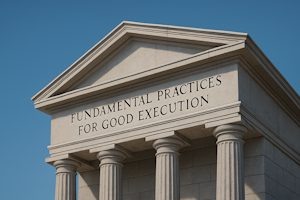
A practical guide to the three execution fundamentals every organisation needs: rapid planning alignment, transparent delivery reporting, and clear product strategy.

In a physical office, presence happened naturally.
You could see who was in early, who was deep in focus, and which leaders had their doors open for a quick chat. Even without speaking, those signals shaped trust and connection.
When teams went remote, those signals disappeared.
Leaders didn’t stop caring - being present didn't magically stop being important. But leaders lost the obvious way of being around. They became harder to find disappearing into the digital ether.
And when leadership becomes invisible, the ripple effects are real, although they can take a while to compound:
Presence in a virtual workplace can’t be left to chance.
It has to be designed.
In remote teams, visibility is about more than knowing someone’s online - it’s about knowing you can approach them.
When people can’t see you, they fill the silence with assumptions:
Imagine each and everytime, you started to type that important message, but stopped... How much easy was it when you saw your leader, and you could just drop in and say, "Hey, Hi, I just wanted to chat about something with you..."
Over time, the digital silence isolates leaders from their teams.
The antidote is intentional presence - not constant availability, but being discoverable when it counts.
1. Create Dedicated Leadership Spaces
Named rooms like “Alex’s Office” or “Leadership Drop-In” give people a clear, predictable way to find you. They’re the virtual equivalent of a door left open, or the regular seat that you'd check for your leader.
2. Set Consistent “Open Hours”
You don’t need to be on all day. Instead, have predictable times when anyone can pop in — weekly AMA sessions, post-standup drop-ins, or regular watercooler chats.
3. Signal Availability, Not Busyness
Instead of relying on Slack or Teams “status” dots, use your virtual office to show when you’re focused, when you’re available, and when you’re in a collaborative mode. Being at the office and by yourself automatically signals you are open and available for a chat.
4. Walk the Digital Floor
The remote version of “management by walking around” still works. With a virtual office where all rooms are visible and easily joinable, a leader can join rooms, observe project discussions, and drop by informal gatherings, and virtual walk the office, staying connected with their entire company without micromanaging.
5. Balance Openness with Privacy
Presence doesn’t mean exposure. Leaders can remain present but protect their private spaces by locking rooms for sensitive conversations, or quiet time. This visibility helps maintain trust and build real digital presence.
Micromanagement thrives when leaders think visibility means monitoring.
In reality, strong remote leadership is about being discoverable:
As hybrid human-AI teams emerge, presence will be even more important. In a sea of automation, what will set leaders apart is their ability to:
The risk of the hybrid workforce of the future where humans will start to work even more frequently with digital team members, is even more disconnection.
If we don't deliberately design the offices of the future with humans in mind, we might just loose the humanity of our organisations.
At Berst, we believe virtual offices are the foundation of an effective future. They will be the places where humans and AI teammates can co-exist, collaborate, and make decisions together. Digital spaces will be where teams can meet naturally with their digital teammates, and create truly amazing outcomes, but we don't want to drive disconnection and disengagement while we do so.
Presence is no longer a by-product of being in the same building. It’s a skill that leaders need to master in both the Digital and Physical worlds.
Those that master it will keep their teams not just aligned, but connected.
Read more about what we think about the future of remote work in The Remote Work Formula

A practical guide to the three execution fundamentals every organisation needs: rapid planning alignment, transparent delivery reporting, and clear product strategy.

Return-to-office mandates miss the point. Discover why hybrid will become the new default and how leaders can design it for culture, retention, and results.

The rise of AI puts leadership at a crossroads: hand decisions to machines or design workplaces where humans and AI collaborate seamlessly.

Discover why the future of work will bring humans and AI teammates together in virtual offices. Learn how conversational AI and digital presence are reshaping collaboration, leadership, and workplace

Culture doesn’t grow by accident. Neither does connection. In physical offices, they emerge from architecture, rhythm, and proximity—none of which translate automatically into remote environments.

Launching The Remote Work Formula — A Guide for the Modern Workplace

Virtual offices are enabling new ways of interacting. Berst allows you to peek through the window, shout out to everyone in the office and check who has been speaking to encourage inclusion.

The magic of a physical office happens between the meetings, not in them. A virtual office like Berst enables you to create this same magic, simply and intuitively. These 3 tips help you do just that.

Remote working is enabling a new way of learning, the ability to leverage shared, recorded video content, but then to focus on the discussion in the room are enabling a new way of working.

Taking a tutoring business online is simple with a modern virtual office like Berst. With a easily accessible virtual office you can work just like you do in person, but virtually.

Berst is a simple and intuitive virtual office, setup to be the most accessible possible for team members of all cultures, ages or dominations. Accessed from your browser, you can get setup tomorrow.

High Empathy is the key to creating an effective working agreement that helps Distributed Teams succeed. This guide with help you with a step by step approach for doing this.

Berst's Virtual Office is perfectly setup to overcome "Zoom Fatigue". If you are looking to enable a highly engaged remote first workforce, Berst's Virtual Office is designed to help.

Creating context is a critical element for designing effective virtual workspaces. Virtual Offices like Berst can enable you to create radical transparency by connecting your context with rooms.

Some facilitation approaches like Ritual Dissent are perfect for high performance teams, as it create the space of high quality feedback. Virtual Offices make this even simpler to run.

Contrary to the common advice, it is possible to align multiple teams around OKRs. When using a virtual office you, don't require physical rooms or movement so you can just focus on aligning.

The watercooler moment is one of the things that people feel has been lost in remote working environment, but Everest Engineering use Berst's virtual office to solve this and feel connected as a team.

Low engagement events is the real killer in virtual working environments. These 3 approaches help build engagement while working in virtual or hybrid events.

Culture codes help set clear expectations about how people work and act. In distributed working environment this can be a key factors in the difference between high and mediocre performance.

Empathy is the key to building an inclusive team, especially in distributed teams when you can't rely on proximity. These 3 simple approaches can help you get off on the right foot.

Effective planning in Agile, allows teams to rapidly make decisions based on all readily available information to create an effective plan. This simple approach helps you do exactly that.

Organisations typically approach creating team alignment by setting and sharing a company vision. But this often falls flat. A Strategy Back-brief enables organisations to bridge the execution gap.